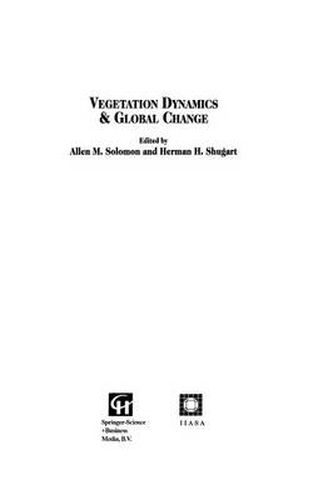Readings Newsletter
Become a Readings Member to make your shopping experience even easier.
Sign in or sign up for free!
You’re not far away from qualifying for FREE standard shipping within Australia
You’ve qualified for FREE standard shipping within Australia
The cart is loading…






This title is printed to order. This book may have been self-published. If so, we cannot guarantee the quality of the content. In the main most books will have gone through the editing process however some may not. We therefore suggest that you be aware of this before ordering this book. If in doubt check either the author or publisher’s details as we are unable to accept any returns unless they are faulty. Please contact us if you have any questions.
During the summer of 1987, a series of discussions I was held at the International Institute for Applied Systems Analysis (nASA) in Laxenburg, Austria, to plan a study of global vegetation change. The work was aimed at promoting the Interna tional Geosphere-Biosphere Programme (IGBP), sponsored by the International Council of Scientific Unions (lCSU), of which nASA is a member. Our study was designed to provide initial guidance in the choice of approaches, data sets and objectives for constructing global models of the terrestrial biosphere. We hoped to provide substantive and concrete assistance in formulating the working plans of IGBP by involving program planners in the development and application of models which were assembled from available data sets and modeling ap proaches. Recent acceptance of the nASA model as the starting point for endeavors of the Global Change and Terrestrial Ecosystems Core Project of the IGBP suggests we were successful in that aim. The objective was implemented by our initiation of a mathematical model of global vegetation, including agriculture, as defined by the forces which control and change vegetation. The model was to illustrate the geographical consequences to vegetation structure and functioning of changing climate and land use, based on plant responses to environmental variables. The completed model was also expected to be useful for examining international environmental policy responses to global change, as well as for studying the validity of IIASA’s experimental approaches to environmental policy development.
$9.00 standard shipping within Australia
FREE standard shipping within Australia for orders over $100.00
Express & International shipping calculated at checkout
This title is printed to order. This book may have been self-published. If so, we cannot guarantee the quality of the content. In the main most books will have gone through the editing process however some may not. We therefore suggest that you be aware of this before ordering this book. If in doubt check either the author or publisher’s details as we are unable to accept any returns unless they are faulty. Please contact us if you have any questions.
During the summer of 1987, a series of discussions I was held at the International Institute for Applied Systems Analysis (nASA) in Laxenburg, Austria, to plan a study of global vegetation change. The work was aimed at promoting the Interna tional Geosphere-Biosphere Programme (IGBP), sponsored by the International Council of Scientific Unions (lCSU), of which nASA is a member. Our study was designed to provide initial guidance in the choice of approaches, data sets and objectives for constructing global models of the terrestrial biosphere. We hoped to provide substantive and concrete assistance in formulating the working plans of IGBP by involving program planners in the development and application of models which were assembled from available data sets and modeling ap proaches. Recent acceptance of the nASA model as the starting point for endeavors of the Global Change and Terrestrial Ecosystems Core Project of the IGBP suggests we were successful in that aim. The objective was implemented by our initiation of a mathematical model of global vegetation, including agriculture, as defined by the forces which control and change vegetation. The model was to illustrate the geographical consequences to vegetation structure and functioning of changing climate and land use, based on plant responses to environmental variables. The completed model was also expected to be useful for examining international environmental policy responses to global change, as well as for studying the validity of IIASA’s experimental approaches to environmental policy development.